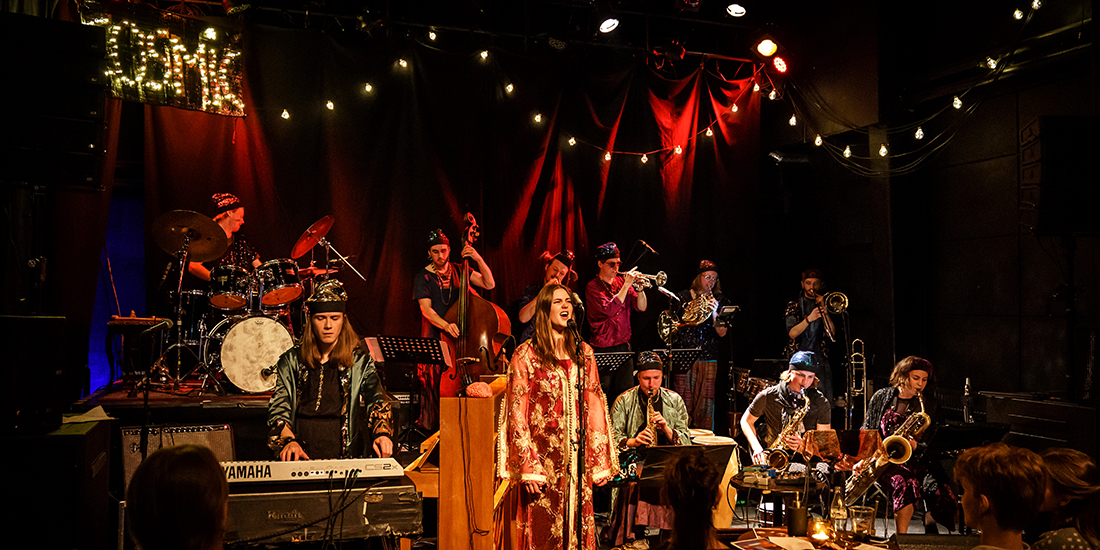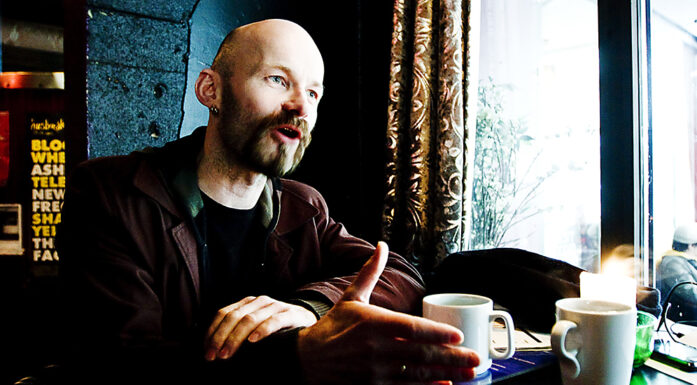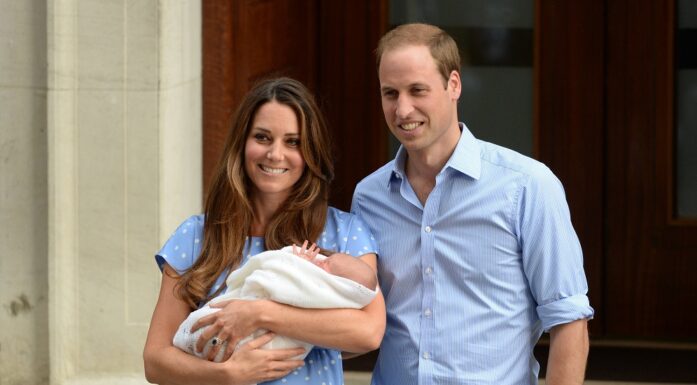The jazz hatchery
NTNU’s Jazz Programme has produced a long line of talented musicians and bands who are making their mark both nationally and internationally. Peer learning and nerding out are two of the key ingredients in the recipe for success.
The room is dark and packed to the brim. On stage are 15 young musicians. The students radiate their joy in playing and entrance the audience with their music. They take us on a journey through many different landscapes.
The horn section plays at the back, the piano, cello, violin, double bass, vibraphone and drums at the front. More young musicians keep entering the stage during the performance, meaning many get to participate.
The vibe remains high all the way through.
This was the NTNU Jazz Ensemble performing compositions by Maria Kannegaard at the Dokkhuset concert stage during Trondheim Jazzfest 2025.
Kannegaard was a Jazz Programme student 30 years ago and has since greatly influenced Norwegian jazz. Last year, she received the prestigious ‘Buddy Award’ in Norwegian jazz.
Eirik Hegdal gently guides the students through the concert. He is one of the Jazz Programme’s instructors and has a hand in much of what goes on in the jazz community at NTNU. This year, he received the ‘Buddy Award’.
Music in your body
“It was a lot of fun and such an honour! And the music was lovely – really cool to play,” said Mòei∂ur Loftsdóttir. She is a first-year student in the programme and plays the trumpet.
“There are lots of great, talented people to play with and draw inspiration from in the Jazz Programme. And the teaching is fantastic – they focus on internalizing the music. This means the music goes through your body, which is your first instrument. When you are learning new music, you should sing it, hum it, clap the rhythm – and once the music has been absorbed into your body, only then do you play it on your instrument,” she said.
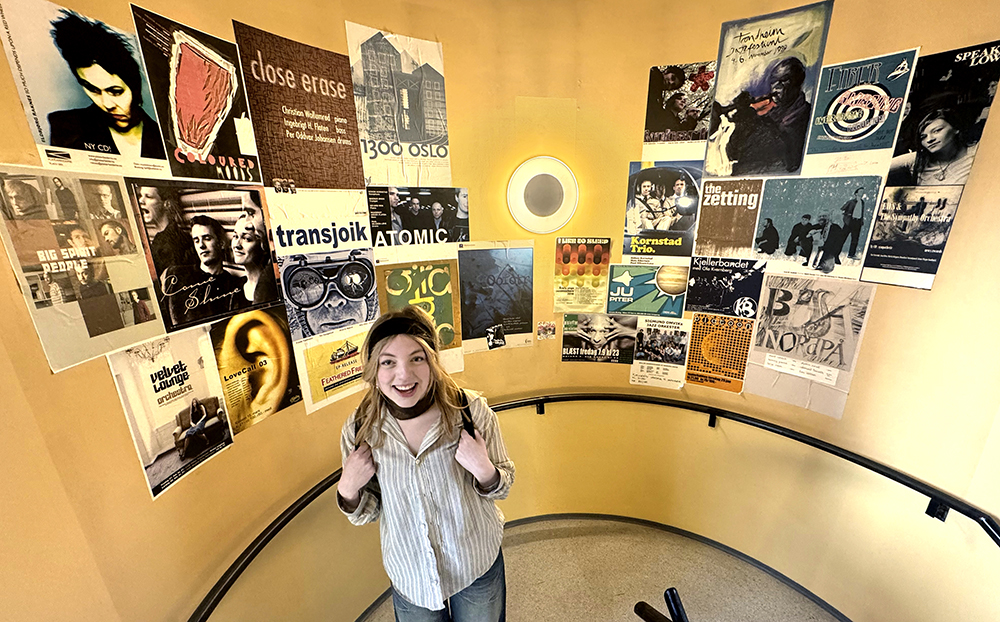
The stairwell leading to the Jazz Program is filled with concert posters featuring musicians from the programme. First-year student Mòei∂ur Loftsdóttir has already made her debut on the concert stage.
Photo: Idun Haugan
Life in the Jazz Programme
The Jazz Programme’s premises are tucked away in a side street in the heart of Trondheim, in close vicinity to the city’s concert venues and music pubs, including Dokkhuset.
The staircase that winds up through the floors is covered in posters from concerts that students have held over the years. There are a lot of familiar names. Music leaks out of all the practice rooms. Three jazz teachers give us a tour and share stories from life in the Jazz Programme.
“This place has nurtured a band scene like no other,” said Erling Aksdal. He is a former head of studies and has helped develop the programme’s distinctive character.
He and the other founders decided early on in the process that they did not want the Jazz Programme be like other music schools.
Eirik Hegdal and Kirsti Huke, both associate professors, have maintained and developed this unique learning environment, which has been a major influence on the Norwegian jazz scene for many years.
“Graduates pursue very different careers and are musically very diverse,” Huke said.
In the nerd bubble
The fact that students are given the space and time to develop their individual musicality and style is one of the programme’s key ingredients. There is a focus on preserving individuality.
“Nerding out is important,” said Hegdal.
The emerging jazz musicians do not just nerd out individually; they also do a lot of nerding out together. They find each other and experiment in different constellations. The Jazz Programme embraces the philosophy of bringing out the best in each other.
Many famous jazz bands and established musicians first connected during their studies here, including Come Shine, Farmer’s Market, the Vigleik Storaas Trio, Trondheim Jazzorkester, and the Cosmic Swing Orchestra.
Peer learning
“We practice peer learning here, rather than instruction. The whole school is based on the concept of learning by doing. It is the most natural way to learn,” said Aksdal.
Aksdal explains that in the early days of jazz, much of the learning took place in American bars and brothels where jazz culture was emerging. They were places where black musicians played and performed, because they were not allowed to perform elsewhere. They learned from each other, and they learned through playing and experience. While the Jazz Programme certainly does not try to recreate exactly these conditions, its learning methods incorporate elements from that jazz culture.
Kirsti Huke emphasizes that the teaching approach includes theory, but that theory comes second.
“Firstly, the students learn to perform music through imitation. They then use theory to be able to put names to the different phenomena,” she said.
Learning environment
There is much talk in the education sector about establishing good learning spaces. The Jazz Programme focuses more on creating a good learning environment.
When everything suddenly clicks into place and they crack the code, it is absolutely amazing. It’s like opening a floodgate.
They may not have the fanciest facilities, but the practice rooms are constantly buzzing with music, jamming sessions and improvisation. These are the most important classrooms.
“The learning environment is essential. It plays a key role in what we do and is something we focus on all the time. It is a learning bubble, and that bubble needs to be safeguarded. Our teaching approach is about facilitating learning. Musical development can only happen within the individual,” said Hegdal.
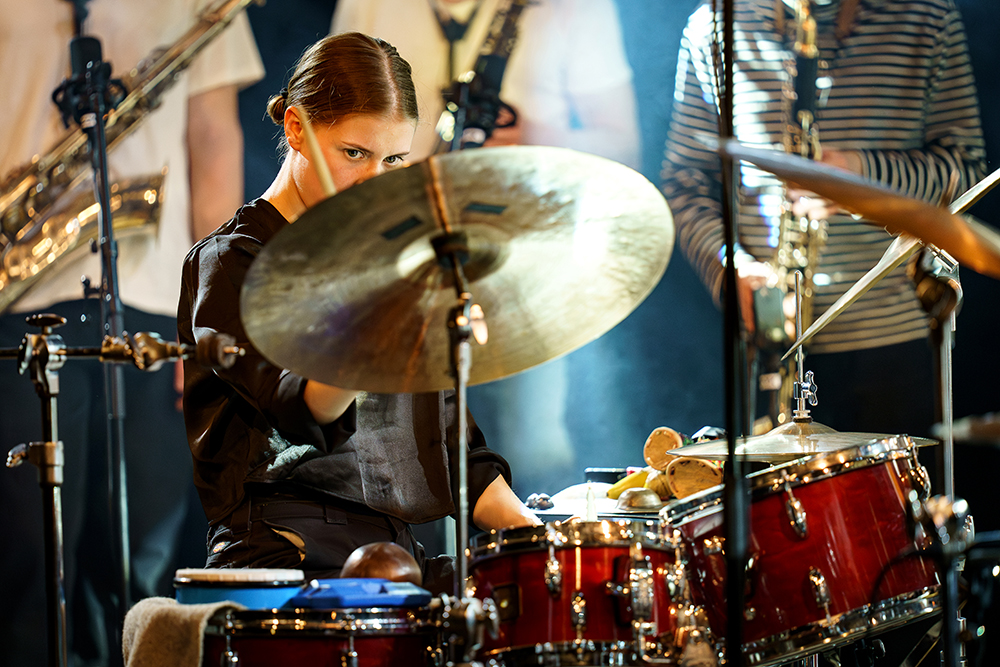
Former student Veslemøy Narvesen is a drummer, multi-instrumentalist, and composer. Today, she plays in several bands and has released music as a solo artist. Photo: Thor Egil Leirtrø
Planking
“We have a flexible teaching philosophy that focuses on the individual,” Hegdal said. At the same time, the teaching is meticulously planned and based on years of experience.
This is an embodiment of the music – getting the music into the body by listening and absorbing it through singing, clapping the rhythm and finding the heartbeat of the music.
A key part of the methodology builds on what is known in the jazz community as ‘planking’.
“This is an embodiment of the music – getting the music into the body by listening and absorbing it through singing, clapping the rhythm and finding the heartbeat of the music. It is like a mother tongue that you learn by listening and practising words and sentences. When you are in the process of learning a new piece of music, you don’t start by playing it on your instrument – you approach the music through ‘planking’ and integrate it into your body first. We are very thorough in our methodology. This way of learning can be a lengthy process, and we give it the time it takes. Many students struggle a bit during their first semester because there is so much to absorb and so many paths to choose between. We open the doors to the academic content, but it is up to the students themselves to crack the code,” Hegdal said.
“It’s important to help the students understand that the process takes time. Because when everything suddenly clicks into place and they crack the code, it is absolutely amazing. It’s like opening a floodgate,” said Huke.
- You might also like: If everyone is musical, why am I afraid to sing?
Colours the city
The students are not just in the nerd bubble while at the Jazz Programme’s locale – they also leave a distinct mark on the city’s music scene. Trondheim’s music venues are a kind of extension of the classrooms.
“It is easy to make things happen here. Trondheim is just the right size – close-knit communities can be forged in a city that is not too big. There is an active jazz scene in the city, and it is a receptive, warm and open community. Trondheim’s venues are a fantastic showcase for the students, and students can often be seen performing around the city,” said Hegdal.
The students perform concerts, and teachers and students also perform together.
“In addition, the jazz annex at NTNU, where we are based, is small enough that teachers and students run into each other all the time,” he explained.
Annual tour
The Jazz Programme also goes on an annual tour of Norway. The students do everything themselves: they create the music, book venues, manage the finances, plan transport and accommodation for the trip, design concert posters, and much more.
“The tour gives them a lot of professional experience. It is important that the musicians who graduate from here are independent individuals, because they are going to have to create their own jobs and build their own market, each with their unique portfolios,” said Hegdal.
Only male students to start
When the Jazz Programme started in 1979, only men applied. For the first time this autumn, however, the male/female ratio will be 50/50. The first woman to graduate was Eldbjørg Raknes, in 1994. Today, she is a professor.
“The Jazz Programme has been a part of my life since I was a student. I started teaching and took on a lot of responsibility during my final year as a student. The Jazz programme has been a continuous part of my professional life ever since,” Raknes said.
Potential over ability
In the early 2000s, ability was replaced by potential as the main criterion for admitting new students.
“When admitting new students, it is important that we place the main focus on potential – which is individual, distinctive and diverse. The Jazz Programme has led to many great musical encounters for many people, producing lots of wonderful, passionate and incredibly diverse music,” she said.
Eldbjørg Raknes sums up the keys to success like this:
- planking method
- desire–listen–play–learn
- experience-based learning
- focus on a good learning environment
Musical identity
Isabelle Eberdean graduated in 2020 and has been working as a musician ever since. She combines soul and R&B with jazz and modern pop, and this year was nominated for the Spellemann (Norwegian Grammy) Award for her EP ‘Freewheeling’.
“The Jazz Programme gave me plenty of time to figure out who I wanted to become as a musician. Even though I am more in the R&B/soul genre at the moment, I had three full years to truly discover my musical identity. The Jazz Programme was great for me because it gave me the opportunity to meet brilliant musicians and not least future colleagues. Making your way into a music community isn’t always that easy. I feel very lucky to still be playing with many of the musicians I studied with during the Jazz Programme,” Eberdean said.

The teachers are great at supporting bands and musicians who are currently studying or have studied at the Jazz Program, says Isabelle Eberdean. Photo: Aleksandra Suchkova
Unconventional mix
Eberdean said she believes that part of the Jazz Programme’s recipe for success is that it admits motivated and promising musicians who want to pursue a career in music after their studies.
“Especially in recent years, they have been good at admitting an unconventional mix of musical talent, which has led to the formation of some really cool bands. The teachers are also very good at cheering on the bands and musicians who are currently studying or have studied there. This gives recent graduates greater access to the music industry. Getting to play in different ensembles is also something I would like to highlight. Last but not least, my classmates really meant a lot to me during my studies. Especially when I lacked motivation, it was important for me to have their support,” said Eberdean.
- You might also like: Do you have an ear for languages? It may be related to how you perceive the rhythms
The Miracle Concert with Chick Corea
Trondheim Jazz Orchestra has been around for a quarter of a century, and its ever-changing line-up is drawn from a large pool of musicians, many of whom have studied at NTNU’s Jazz Programme in Trondheim.
Erlend Skomsvoll, who was a student in the late 1990s, has been a key figure in the Trondheim Jazz Orchestra. In 2000, the orchestra performed a concert with the world-renowned pianist Chick Corea, featuring Erlend Skomsvoll’s arrangements of Chick Corea’s music.
This concert was held at the Moldejazz festival and was later dubbed the ‘Miracle Concert’.
Corea said the concert was “too good to happen only once.” This marked the beginning of a long collaboration between the Trondheim Jazz Orchestra and Chick Corea. Concerts Norway organized a nationwide tour of Norway with eight sold-out concert halls.
In 2005, Live in Molde was released, featuring recordings from the ‘Miracle Concert’.
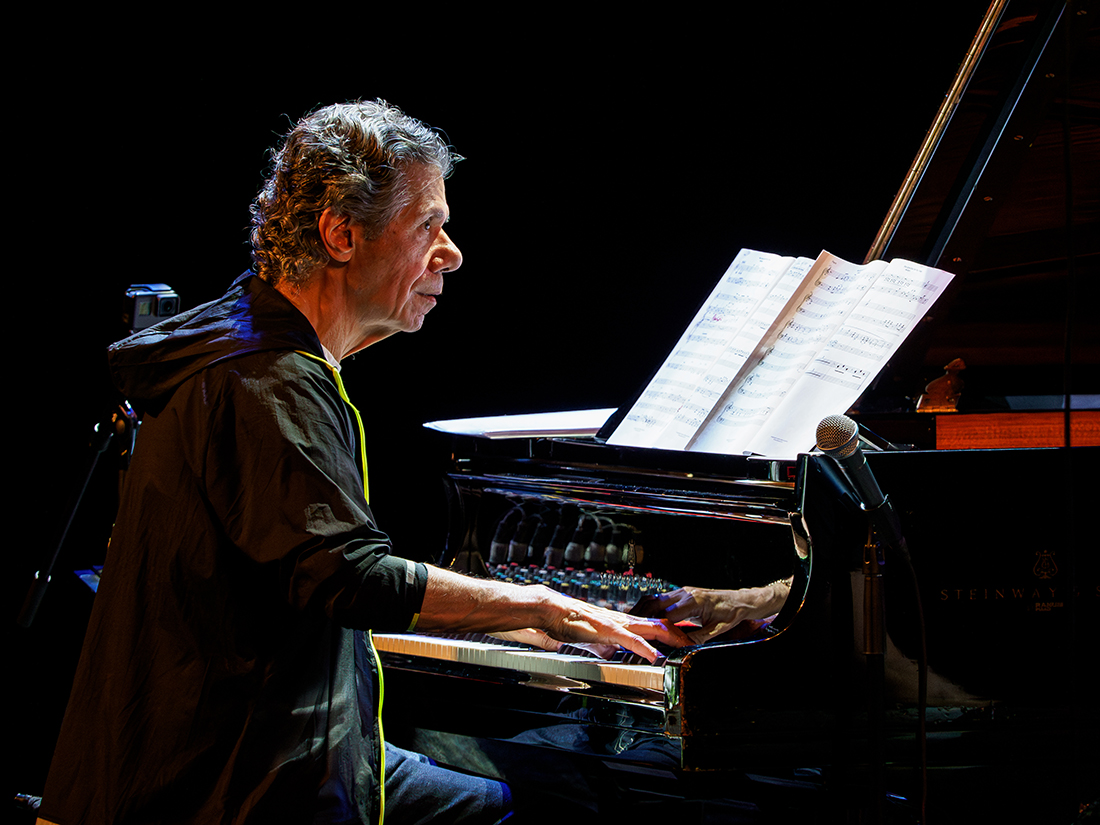
Piano legend Chick Corea and the Trondheim Jazz Orchestra had a long-standing and rich collaboration. The photo is from a concert at Dokkhuset in Trondheim in 2010. Photo: Thor Egil Leirtrø
NTNU honorary doctor
In 2010, there was a tour in Norway and Sweden, and during the concert at Dokkhuset in Trondheim, Chick Corea was awarded an honorary doctorate from NTNU. In 2016, the Trondheim Jazz Orchestra was invited to Chick Corea’s 75th birthday celebration in New York. There, they performed four concerts together at the legendary Blue Note Jazz Club.
The last tour with Chick Corea and the Trondheim Jazz Orchestra took place in 2018, featuring three concerts in Norway.
